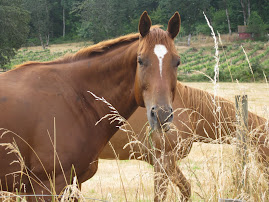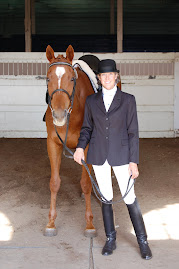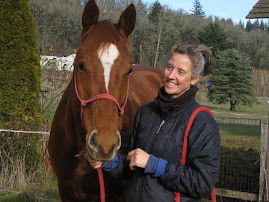The Longissiumus Dorsi is called the "Long Back" muscle for a good reason...It extends from the Pelvis to the Cervical vertebrae (neck bones). That is a looooooonnnnnggggg way.
It is the muscle that the saddle, and essentially, YOU sit on. (The other back muscles that accompany it are: the Spinalis and the Illiocostal, respectively)
It may be the most important muscle in the Equine body when it comes to riding. It is important for TWO reasons:
1) Since the saddle sits on this muscle, the Longissimus is influenced greatly by HOW and WHERE the saddle fits. A poorly fitting saddle is like a poorly fitting shoe. Painful. Restrictive. Just plain uncomfortable. It may sit too far forward, to far back, be too tight, be too loose, be too small, be too big. These saddle issues create problems for not only the horse and his muscles, but the rider and his/her balance, as well.
A well fitting saddle is, of course, the opposite - Comfortable. The well fitting saddle sits in balance to the shape of the horse's back. It allows for movement through the shoulder, back, ribcage, loin and hindquarters. The rider is able to stay in balance while in the saddle. Saddle fit is one of the first things that should be checked before riding your horse. There are professional saddle-fitters that will make house calls and get you a great saddle.
2) How the muscle is used. In the walk & trot- the Longissimus Dorsi moves back and forth on either side of the back. When the left side goes "forward", the right side goes "back", and vice versa. In the canter - the muscle moves ALMOST together, with the "inside" muscle coming forward with the stride and bit sooner then the "outside."
Now - try to visualize this muscle movement. Can you see the back swing in the trot? What about in the canter?? Can you see the "long back" muscle moving? Great.
Now - visualize it with a poorly fitting saddle...AND the rider. Try first with a saddle that is too tight. Then with a saddle that is too big. How about that is too far forward. What can you see in the horse's movements?
Too Tight - This pinches the back and shoulder area like a shoe that is laced too tight. In turn, the back drops to avoid the pinch, the horse's head comes up, and the stride becomes short and choppy. There is no swing over the back.
Too Big - There are a few problems here: the saddle may slide up onto the shoulders, restricting the forward and backward movement of the scapula. Essentially, the shoulder is blocked much like the saddle that is too tight. Another problem may be that the saddle drops back and downward behind the shoulders. This causes a pinch behind the withers and the saddle may actually sit on top of the withers. This can also cause the back to drop, the head to raise up, and again, no swing over the back. Then there is the saddle that just moves all over the place. Without a good fit, it moves forwards, backwards, sideways...imagaine trying to keep your balance with not knowing where the saddle will be next. That goes for horse AND rider!
Obviously, a well fitting saddle will sit correctly and give the horse and the rider a good fit and a good ride.
With a well fitting saddle, there are no pressure points. The weight of the rider is evenly distributed throughout the saddle. This is seen by an even sweat mark left by the saddle.
There is plenty of room for the shoulder to move. You can test this by putting the saddle on and moving the front leg up, forward, and back to see where it moves adjacent to the saddle.
Also, the channel of the saddle is W I D E enough to allow room for the spinous processes of the vertebrae. The channel should sit on either side of the vertebrae using a hands width as measurement.
Finally, there should be ample room in the pommel area for the withers. Your hand should easily fit inside and down into the saddle's channel.
Now these are the BASICS about saddle fit. And I know it seems like common sense. Even so, the next time you head out to ride your horse, check these basic points on your saddle.
If your saddle is a great fit, you will be on the road to keeping your horse's long back muscles healthy. With healthy muscles your horse's back will swing, his head will naturally relax and lower, and he will push correctly with his hindend. Creating a overall healthy horse will lead to his longevity and years of great riding.
Sunday, November 6, 2011
Subscribe to:
Post Comments (Atom)




No comments:
Post a Comment